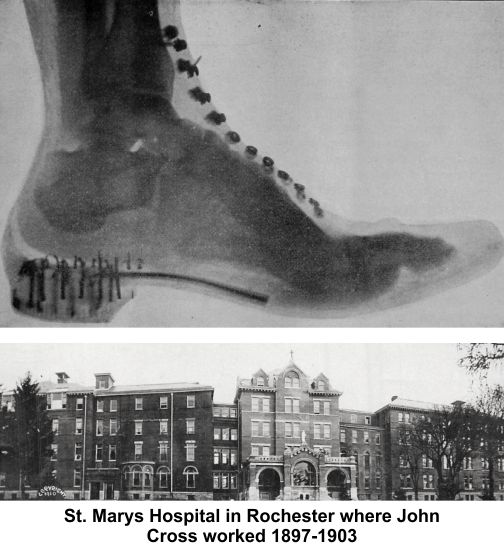|


Enlarge
|

|
From Rochester to Minneapolis
For the first seven years, Dr. John G. Cross (1870–1928)
practiced medicine in his hometown, Rochester,
Minnesota, at St. Mary's Hospital. He had graduated
from Northwestern in 1895, the year German scientist
Wilhelm Roentgen discovered x-rays. Not unlike young
people today with an affinity for technology that
sometimes challenges their elders, John's mastery of
radiography soon brought recognition from older
physicians in Minnesota.
One of those was the influential Dr. William J. Mayo
(1861-1939), co-founder of the Mayo Clinic, with
whom John Cross worked at St. Mary's. At an 1899
medical conference, Mayo praised the excellence of
John's Roentgen skiagraphs (x-rays), no small
feather in the cap of a man just four years out of
medical school.
Perhaps he would have become part of the Mayo Clinic
had John remained in Rochester, but in mid-1903, he
became part of the visiting staff at Minneapolis
General Hospital as a clinical bacteriologist in the
pathology department. By December, he was preparing
to leave Rochester to accept a full-time position at
Minneapolis General.
Iroquois Theater
On December 30, 1903, Dr. John Cross was in Chicago and had just left the
Reliance Building on Washington Street when he
was drawn to the fire alarm. He saw nothing of great
note so walked on to the Marshall Fields Department
store. By then, the injured had begun to appear a
makeshift first-aid area was being set up in the
store. An elevator operator persuaded him to assist.
Bio bits
John was the son of a
Dr. Edwin C. Cross and Fanny Marcy Cross. He
graduated from the University of Minnesota in 1891,
married Frances L. Montgomery in 1894, and received
his doctorate from Northwestern in 1895. Over the
next eight years, he and Frances had three children.
Misleading interview and newspaper story (left)
This story tries my patience. Before the fireball at
3:50 pm, the only instantaneous deaths inside the
Iroquois auditorium happened when a few people
jumped from a balcony to the first floor, killing themselves or those they
landed upon. After the fireball, virtually NO ONE
exited the auditorium, so all trampling had stopped.
When firefighters gained entrance shortly after the
fireball, the theater was nearly silent. It was
filled with four hundred corpses. They found "a few"
people beneath corpses, spared the flames. So few
that the only one I've found identified in news
stories was
Elizabeth Clingen. E. Dr. Cross's theory that
people only trampled the dead is nonsense. They
trampled the living until the living became the dead
as a result of that trampling, then they trampled
the dead until the fireball came. After that, there
was no one left alive inside to do any trampling.
At best, the doctor's remarks are an example of why
it's a poor idea to go public with an opinion before
all the facts are in. At the Coroner's inquest into
the cause of the Iroquois Theater disaster, witness
testimony revealed a pattern that was repeated over
and over. Knocked or pulled to the floor by others,
misfortunates begged and pleaded for help in
regaining their footing. People who tried to give
them a hand were pushed by the oncoming crowd behind
them to keep moving. Some of these were knocked down
and became trampled themselves. Those who lived to
testify about their experience had kept moving.
Shouting, "Wait!" doesn't work in an environment
with hundreds of screaming people.
Terrified people who can't find loved ones in a
life-threatening situation become loud. Those coming
up the aisle from behind couldn't see a downed
person ten people ahead, in the dark, and they too
were being pushed from behind. If the chain-reaction
sequence started at the front of an outer aisle
(front = closest to stage), where there were fewer
people trying to exit, there were fewer layers in
the pile, and the downed victim had a better chance
of extricating himself and standing. If it happened
in the middle of a center aisle, he suffocated under
the weight of hundreds of pounds of other human
bodies compressing his chest, making it impossible
to expand his lungs enough to inhale the
smoke-filled air. The story has the distinction of
being the only one in which references elsewhere to
piles of corpses inside the theater were confused
with first responders' treatment of the dead.
In the years after the fire
John became a fixture
in the Minneapolis medical community, serving as
president of the Hennepin County Medical Society and
Chief of Medicine at Minneapolis General Hospital,
as well as practicing at other area hospitals,
including Abbott and Hill Crest. He was also a
faculty member at the University of Minnesota in
Minneapolis.
|
